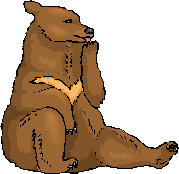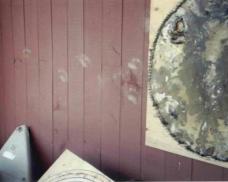What
could
these three critters have in common?
Last spring toward the end of my trapping season, there
were
just a few
problem beaver yet to catch, skin, and stretch. I
came home one morning with the last three culprit beaver, which
were causing problems for a local town road agent and his crew. (A long
rap
sheet for plugging up culverts and bridges, flooding the roads, and
undermining
the road base, all at considerable expense to the town brought about
their
demise. These three problem beaver were
finished in their careers of roadway sabotage.) As I usually do when we
have
warm sunny weather, I laid the beaver on the picnic table beside my
barn. I proceeded to brush the fur to
remove mud
and burs, first in the direction that the fur would normally lay, and
then in
the opposite direction which made it fluff up nicely for drying.
Typically I
would leave the beaver in the sun for a few hours to dry before
starting the
skinning process. I got in my truck and
left the farm for a few hours. Upon my return, I made the curve in the
driveway
going around the house bringing the barn and picnic table into view. I
was
presented with the interesting site of five buzzards standing on the
big table
contemplating the beaver carcasses, while others circled above. Noise from the worn out suspension of my old
truck was enough to scatter the buzzards and luckily they had not yet
done
significant damage to the hides. This
whole scene was quite interesting and I wish that I had a camera in the
truck
at the time. One of the beaver was pecked a little, but nothing as bad
as some
of the typical cuts and gashes normally found in spring beaver when
they are
fighting among themselves for territory.
Surmising that perhaps
it would be
better if I didn’t leave whole beaver unattended in the future, I got
on about
my business. I rough skinned all three beaver, and then removed the
excess fat
on a hardwood beam utilizing a knife designed specifically for this
purpose in
a process called fleshing. Next, I tacked each fleshed hide on a
plywood
stretching board. Concentric oval patterns based on size and form, are
marked
on each board to guide the fur handler when tacking the hides. These
boards are
referred to as stretcher boards. In reality their purpose is not so
much to stretch
as to secure the hide in the shape desired by the fur industry while
the
remaining fat and oil is air-dried from the tissue. Up until the event
I am
about to elaborate, it was my practice to hang my stretched and drying
beaver
pelts in the open machine shed on the backside of my barn. The machine
shed
provided a good and airy location protected from possible rain. Those
three
hides went up on the wall along with about fifteen others, which were
not yet
dry. The next day I went to the machine shed intending to put the
rototiller on
the back of the tractor and begin working the fields.
One of the stretching boards was lying halfway up the back
pasture and another was about twenty yards outside the machine shed
with the
pelt ripped off and nowhere in sight. Several ragged or tattered hides
were
lying on the ground around the various pieces of equipment and a few of
the
hides were partially ripped off the boards hanging down off the wall. It was quite a site of destruction but it
didn't take long to realize what happened.
Some of the remaining pelts had claw marks as sure
evidence
indicting
the large predator, which had been dining on my beaver hides. Additionally the backside of my barn was
covered with muddy paw prints, which identified the marauder as a
fairly decent
size bear. There were tracks on the
lawn tractor seat where the bear had climbed up onto the tractor to
reach some
of the additional hides. Seven hides
were consumed or otherwise damaged.
Three hides were totally missing, most likely consumed.
Two
hides were
ripped to shreds and partially consumed along with the nails I used to
tack
them to the boards. I guess the bad bear got a little fiber in that
meal. Two
other hides were somewhat damaged and although significantly devalued
still saleable,
or at least I shipped them to auction.
There are a lot of
lessons for a
trapper to learn; when is the ice safe enough for me to go get those
beaver out
in the middle of the big marsh? Boy! Those big coni-bear traps can
hurt. I
guess we should have balanced the load in the canoe? How many critters
do I
have to skin before I stop poking them full of holes? Maybe I
shouldn’t leave
beaver on the picnic table when the buzzards return in the spring, or
hang
hides on the backside of the barn when the bears are fresh out of
hibernation?
|




